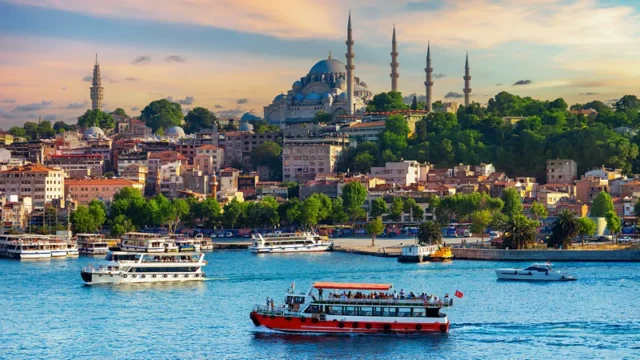Introduction
Revitalizing Istanbul: A Comprehensive Restoration Campaign
Istanbul, Turkey‘s largest city, is a vibrant metropolis that bridges Europe and Asia, renowned for its rich history, stunning architecture, and bustling cultural scene. It is one of the world’s most visited cities, is undergoing a significant cultural and heritage restoration campaign. This initiative aims to uncover previously overlooked historical layers and make them accessible to the public.
Restoring Bulgur Palas: A New Cultural Hub in Istanbul
For decades, the dome-topped turret of Bulgur Palas in Istanbul’s central Fatih district was barely visible behind high walls. Today, this century-old mansion offers panoramic views of the Marmara Sea, the historic peninsula, and the city’s new business district. Restored and reopened in February 2024, Bulgur Palas now serves as a cultural center with a 150-seat library, exhibition space, garden café, and observation terrace. This former Ottoman Bank archive is just one of many sites that have been made accessible to the public in recent years.
Unveiling Hidden Gems
Since 2019, Mahir Polat, deputy secretary-general of the Istanbul Metropolitan Municipality (İBB), has led a city-wide restoration drive. This effort has transformed dozens of previously inaccessible sites, ranging from Byzantine-era fortifications to late-Ottoman-period factories, into public attractions. The restoration projects aim to create new public spaces and revitalize historical sites at risk from earthquakes and urban development.
Addressing Overcrowded Tourist Spots
With 20.2 million international visitors in 2023—a 26% increase from 2022—Istanbul’s top attractions, such as Topkapı Palace, Hagia Sophia, and the Basilica Cistern, often face long lines. Tour guide Sinan Sökmen, founder of Istanbul Tour Studio, believes that opening additional landmarks can help distribute tourist traffic more evenly across the city. One example is the Gülhane Park Cistern, a 1,500-year-old reservoir restored and reopened in early 2023. Located just a 10-minute walk from its larger counterpart, this site offers a glimpse into the city’s extensive cistern system.
A Multi-Layered History of Istanbul
Istanbul’s history dates back to the 7th Century BCE, and it has been the capital of the Roman, Byzantine, and Ottoman empires. The city is unique in having served as the capital of consecutive Christian and Islamic empires and spans two continents: Europe and Asia. In the century since the establishment of the modern Turkish Republic in 1923, Istanbul’s population has surged to roughly 16 million people, making it the largest city in Europe. This rapid growth has led to a building boom, leaving many ancient monuments surrounded by concrete.

Revitalizing Industrial Heritage of Istanbul
Preserving Istanbul’s industrial heritage, which represents significant chapters in the city’s transition from the Ottoman era to the Republic, has been a focus of the municipality’s restoration efforts. Many 19th and early 20th-century residential and industrial sites have been neglected, despite their historical importance. For example, Casa Botter, a 1901 apartment in the Beyoğlu district, has been restored and reopened as a public art and design center. Similarly, Artİstanbul Feshane, a 19th-century weaving factory, now hosts exhibitions and retains its original cast-iron columns.
Balancing Preservation and Modernization
The restoration efforts have not been without criticism. Architecture professor Gülsün Tanyeli argues that the revitalization projects often focus on preserving the structures without adequately conveying their historical significance. For instance, Müze Gazhane, a former gasworks turned cultural complex, could provide more information about its past production processes and the local activists’ efforts to protect it from destruction.

Criticisms and Controversies in Istanbul
The restoration of Istanbul’s 5th-century city walls has also faced criticism for not sufficiently preserving the garden plots along their base, where food has been grown for centuries. Despite these concerns, the restoration projects have generally been well-received by Istanbul residents, creating “living places” where visitors can engage with contemporary daily life.
Anadolu Hisarı: A Reopened Ottoman Fortress
Anadolu Hisarı, the oldest Ottoman fortress in Istanbul, reopened in May 2023 after being closed for over a decade. This historic site, built in 1395 to establish Ottoman dominance over the Bosporus, now attracts families and couples who enjoy its scenic views and free open-air concerts organized by the municipality.

Embracing Istanbul’s Heritage
Mahir Polat emphasizes the importance of protecting Istanbul’s heritage and making it accessible for everyone to experience. By doing so, he believes that Istanbul will be even more cherished by residents and visitors alike.
Conclusion: Istanbul
Istanbul’s extensive cultural and heritage restoration campaign is uncovering and revitalizing the city’s rich history. From restoring century-old mansions and Ottoman fortresses to transforming industrial heritage sites into cultural hubs, these efforts are creating new public spaces and spreading tourism more evenly across the city. While the initiatives face some criticisms, they are generally embraced by the public, contributing to a deeper appreciation of Istanbul’s unique cultural and historical tapestry.











